University of Portsmouth gender pay gap figures
The gender pay gap shows the difference between the average (mean and median) earnings of men and women and is expressed as a percentage of men’s earnings.
A gender pay gap above zero will show that, on average, men earn more. Complying with statutory calculations, the University has identified its gender pay gap in relation to the:
- mean and median difference between hourly rates for males and females
- the mean and median difference between bonus pay for males and females
- the proportions of male and female employees who were paid bonus pay
- the proportions of male and female employees in each pay band quartile
Mean and median pay gap
The mean pay gap is the difference between the average hourly rate of pay between males and females. The University’s mean pay gap is 14.8% which is lower than the wider economy in England for 2019 (16.3%) and broadly comparable with the pay gap within the HE sector Universities falling within the income bracket of £202m-£400m for 2019 (15.2%). This is a 0.2% increase in the pay gap compared with the previous year (14.6%).
The median pay gap is the difference between the middle point of average hourly rates (when listed in numerical order) of pay for males compared to the middle point of average hourly rates of pay for females. The University’s median pay gap is 23.3% which is higher than the wider economy in England for 2018 (17.4%) and higher than the HE sector Universities falling within the income bracket of £202m-£400m for 2019 3 (13.7%). This is largely due to the significantly higher proportion of female staff at the lower grades within the University’s pay structure. This represents a 1.0% increase when compared with the previous year (22.3%).
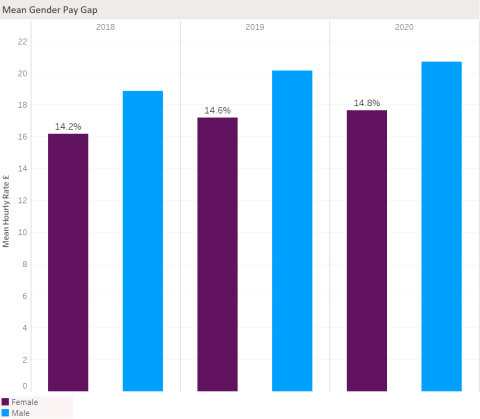
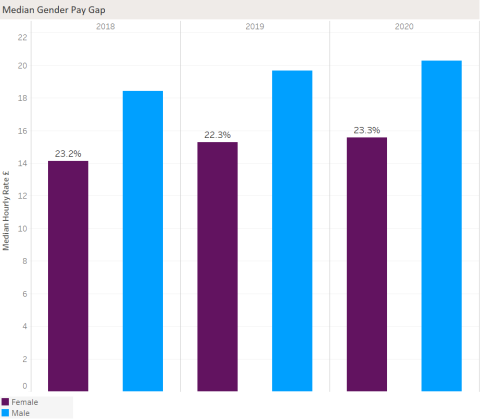
Gender bonus gap
In the reporting period covered by this report, bonuses paid within the University are paid via Recognition Awards (to individuals and teams who have excelled in their performance) and via Staff Vouchers (£200 paid to eligible staff in December 2019).
The mean bonus gender pay gap shows the difference between the average bonus pay received by male and female staff. The University’s mean gender bonus gap is -6.7% (therefore in favour of females), compared to a gender pay gap of 30.3% reported in the previous year.
The median bonus gender pay gap for University staff has remained at 0%, which is consistent with previous years.
The significant improvement in the mean bonus gap reflects the fact that the majority of staff received a bonus by way of vouchers in 2019. The Graph below represents the gender pay gap against the four hourly rates to be reported via the Government portal. Three of these show very little change since the first reporting began in 2018, other than that of the Mean bonus hourly rate which shows a big variation in the years due to the points outlined above.
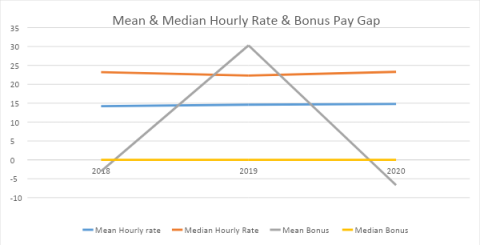
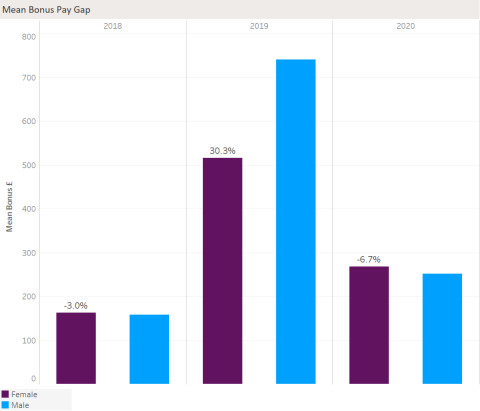
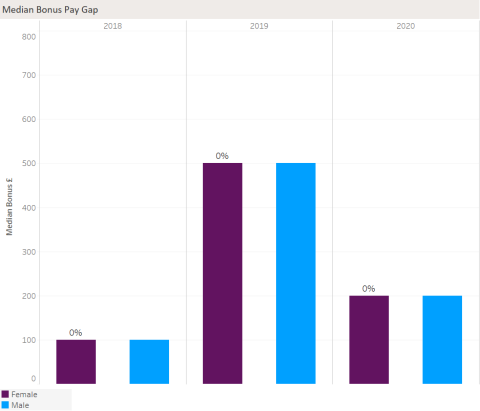
Proportion of male and female colleagues receiving a bonus
The proportion of colleagues across the University who received a bonus under the statutory definition was very close, with 72.0% of females receiving a bonus and 72.4% of males receiving a bonus.
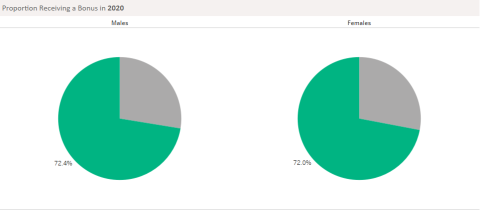
Proportion of male and female colleagues in each pay quartile
The University has identified the percentage of female and male colleagues in each of four pay quartiles, by dividing the workforce into four equal parts.
Female colleagues account for 65% of the lowest quartile and the lower middle quartile, which is the same as the previous year.
The upper middle quartile is more balanced with female colleagues making up 51% of this population compared with 53% in the previous year.
In the upper quartile, the split between female and male is 42% female and 57% male, which remains the same as the previous year.
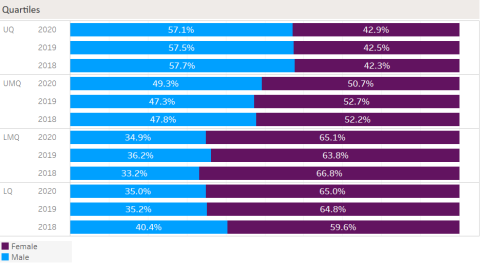
Why we have a gender pay gap
A major contributing factor to the University’s gender pay gap is the significantly higher proportion of females in the lower two pay quartiles, undertaking roles such as administration and catering which traditionally have attracted female applicants. These roles have also tended to provide flexibility around part time working, which is attractive to those with caring responsibilities, historically impacting on women more than men.
Another contributing factor to the University’s pay gap is the higher proportion of males in more senior academic roles, with 22% of professors being female (28 out of 126 as at 17 March 2021). This is not only a concern for the University but a wider known issue across the Higher Education sector.
A way to decrease the gender pay gap would be to increase the numbers of women in leadership positions across the University, particularly in academic roles, and also to ensure that roles at all levels across the University attract a diverse pool of applicants.
The University recognises that many challenges remain and is determined to take action to ensure that our day-to-day practice reflects the quality of our policy commitments.
How we're addressing the gender pay gap
Equality and inclusion is integral to the University’s People Strategy and the University is committed to deliver against its ambitions as outlined in this Strategy.
Athena SWAN Action Plan
The University is very proud to have achieved a Bronze Award for the Equality Challenge Unit (ECU) Athena SWAN Charter, in recognition for work undertaken to address gender equality across the University.
The University is committed to achieving a Silver Award in 2021 and has developed a comprehensive action plan in order to achieve this. To achieve this, it is recognised that there needs to be evidence of delivery of the action plan and impact.
An important element of the Athena SWAN Action Plan is to ensure our recruitment policies and processes support the achievement of gender equality. Examples of actions delivered include unconscious bias training rolled out across the University, criteria around salary on appointment reviewed and monitored, and ensuring that interview panels are gender balanced wherever possible.
A key element of the Athena SWAN action plan has been around providing a flexible, family friendly working environment. The Agile Working Framework provides an opportunity to harness flexible ways of working, which could ultimately breakdown barriers and contribute to opportunities that may reduce the gender pay gap.
Statement
In order to comply with The Equality Act 2010 (Gender Pay Gap Information) Regulations 2017, the University is required to publish gender pay gap information every year for all staff employed on 31 March each year (due to COVID 19 the date has been extended to 5 October 2021 for this reporting year).
Equality, diversity and inclusion underpins all our work and is at the heart of what we are and what we do. Our commitment is not restricted to the minimum legal requirements of equalities legislation, as we aim to deliver best practice whenever possible.
The University of Portsmouth is a diverse, multicultural and international community, committed to working in an inclusive way, developing a workforce that reflects our student community, the City of Portsmouth and the region’s diversity.
We are determined to identify and remove any potential gender bias and to ensure that we have an inclusive culture that values all staff.
The data published in this report is accurate and satisfies the requirements of the Equality Act 2010 (Gender Pay Gap Information) Regulations 2017.
